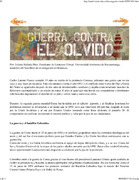Mostrar el registro sencillo del ítem
Guerra contra el olvido
| dc.contributor.author | Saldaña Díaz, Juliana | spa |
| dc.date.accessioned | 2020-10-27T00:09:00Z | |
| dc.date.available | 2020-10-27T00:09:00Z | |
| dc.date.issued | 2013 | |
| dc.identifier.issn | 2145-7190 | |
| dc.identifier.uri | http://hdl.handle.net/20.500.12749/8639 | |
| dc.description.abstract | Carlos Latorre Franco cumplió 19 años en medio de la península Coreana, peleando una guerra que no era suya y muy lejos de su patria. Para ese entonces corría el año 1952 y el conflicto entre Corea del Sur y Corea del Norte se agudizaba después de dos años de interminables combates y dejaba como resultado muertos de diferentes nacionalidades y un estado en ruinas. Carlos al igual que muchos de sus compatriotas colombianos solo buscaba engrandecer el nombre de su país y volver sano y salvo a su tierra. Durante la segunda guerra mundial Corea fue invadida por el ejército japonés, y al finalizar la misma los problemas internos la devastaban a tal punto que la ONU tuvo que intervenir. El país fue ocupado al norte por la Unión Soviética y al sur por Estados Unidos tomando como línea divisoria el paralelo 38. El compromiso era unificar, reconstruir el entorno político y velar por la paz de sus ciudadanos. | spa |
| dc.format.mimetype | application/pdf | spa |
| dc.language.iso | spa | spa |
| dc.publisher | Universidad Autónoma de Bucaramanga UNAB | |
| dc.relation | https://revistas.unab.edu.co/index.php/laterceraorilla/article/view/3007/2501 | |
| dc.relation.uri | https://revistas.unab.edu.co/index.php/laterceraorilla/article/view/3007 | |
| dc.rights.uri | http://creativecommons.org/licenses/by-nc-nd/2.5/co/ | |
| dc.source | La Tercera Orilla; Núm. 10 (2013) | |
| dc.subject | Ciencias sociales | |
| dc.subject | Publicaciones seriadas | |
| dc.subject | Investigaciones | |
| dc.subject | Arte y cultura | |
| dc.subject | Literatura | |
| dc.title | Guerra contra el olvido | spa |
| dc.title.translated | War against oblivion | eng |
| dc.type.driver | info:eu-repo/semantics/article | |
| dc.type.local | Artículo | spa |
| dc.type.coar | http://purl.org/coar/resource_type/c_7a1f | |
| dc.subject.keywords | Social sciences | eng |
| dc.subject.keywords | Serials | eng |
| dc.subject.keywords | Investigations | eng |
| dc.subject.keywords | Art and culture | eng |
| dc.subject.keywords | Literature | eng |
| dc.identifier.instname | instname:Universidad Autónoma de Bucaramanga UNAB | spa |
| dc.type.hasversion | Info:eu-repo/semantics/publishedVersion | |
| dc.type.hasversion | info:eu-repo/semantics/acceptedVersion | |
| dc.rights.accessrights | info:eu-repo/semantics/openAccess | spa |
| dc.subject.lemb | Ciencias sociales | spa |
| dc.subject.lemb | Publicaciones seriadas | spa |
| dc.subject.lemb | Arte y cultura | spa |
| dc.subject.lemb | Investigación | spa |
| dc.subject.lemb | Literatura | spa |
| dc.identifier.repourl | repourl:https://repository.unab.edu.co | |
| dc.description.abstractenglish | Carlos Latorre Franco turned 19 in the middle of the Korean peninsula, fighting a war that was not his and far from his homeland. By then it was 1952 and the conflict between South Korea and Korea of the North was worsening after two years of endless fighting and as a result left deaths of different nationalities and a state in ruins. Carlos like many of his Colombian compatriots he only sought to magnify the name of his country and return safely to his land. During World War II, Korea was invaded by the Japanese army, and at the end of the war, the Internal problems devastated it to such an extent that the UN had to intervene. The country was occupied to the north by the Soviet Union and to the south by the United States taking the 38th parallel as the dividing line. commitment was to unify, rebuild the political environment and ensure the peace of its citizens. | eng |
| dc.type.redcol | http://purl.org/redcol/resource_type/ART |
Ficheros en el ítem
Este ítem aparece en la(s) siguiente(s) colección(ones)
-
Revista Tercera Orilla [259]


